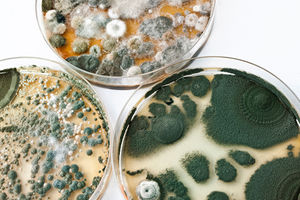 With more than 100,000 known species of mold in our environment, it is easy to see why protecting ductwork and cold water piping is key to the preservation systems and indoor air quality. Mold spores (seeds) are everywhere, indoors and outdoors, in our building materials, on our clothes, and in the air we breathe. We can’t avoid them, but we can minimize their potential for growth in our buildings. And we should. Mold is a common allergen; it exacerbates asthma, and can cause infectious disease in some people. It can also have far reaching legal consequences for owners and others in the construction industry. Mold requires 3 things to grow: (1) food (2) temperatures between 40 to 100ºF and (3) moisture. The best method for controlling mold is to carefully control the moisture in our buildings. This involves much more than wiping up the occasional leak. It requires vigilant control of moisture entry into the building and prevention of condensation throughout our ductwork and cold water piping. Selecting closed-cell elastomeric foams is an excellent way to inhibit the growth of mold on mechanical equipment.
With more than 100,000 known species of mold in our environment, it is easy to see why protecting ductwork and cold water piping is key to the preservation systems and indoor air quality. Mold spores (seeds) are everywhere, indoors and outdoors, in our building materials, on our clothes, and in the air we breathe. We can’t avoid them, but we can minimize their potential for growth in our buildings. And we should. Mold is a common allergen; it exacerbates asthma, and can cause infectious disease in some people. It can also have far reaching legal consequences for owners and others in the construction industry. Mold requires 3 things to grow: (1) food (2) temperatures between 40 to 100ºF and (3) moisture. The best method for controlling mold is to carefully control the moisture in our buildings. This involves much more than wiping up the occasional leak. It requires vigilant control of moisture entry into the building and prevention of condensation throughout our ductwork and cold water piping. Selecting closed-cell elastomeric foams is an excellent way to inhibit the growth of mold on mechanical equipment.
The Nature of Mold
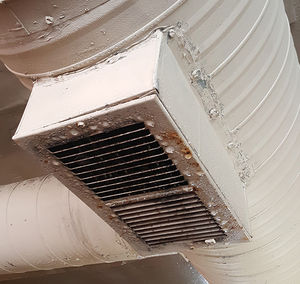 Ideally, buildings should maintain relative humidity of 60% or lower – not only for comfort, but to prevent mold growth. Unfortunately, areas of high humidity are bound to occur in some areas of an HVAC system. High relative humidity levels in air handling units occur any time outdoor air dew points are above the coiling coil discharge temperature (typically 61°F) Air discharged from the cooling coils under these conditions usually has a relative humidity level of 90% or higher. Condensation is another problem, occurring whenever air comes in contact with surfaces that are cooler than the dew point of the surrounding air. This makes cold water piping and cold ductwork prime areas for unwanted moisture. This moisture can condense into liquid at the wrong place and the wrong time, wetting building components such as ceiling tiles, drywall and carpeting, and setting the stage for mold growth.
Ideally, buildings should maintain relative humidity of 60% or lower – not only for comfort, but to prevent mold growth. Unfortunately, areas of high humidity are bound to occur in some areas of an HVAC system. High relative humidity levels in air handling units occur any time outdoor air dew points are above the coiling coil discharge temperature (typically 61°F) Air discharged from the cooling coils under these conditions usually has a relative humidity level of 90% or higher. Condensation is another problem, occurring whenever air comes in contact with surfaces that are cooler than the dew point of the surrounding air. This makes cold water piping and cold ductwork prime areas for unwanted moisture. This moisture can condense into liquid at the wrong place and the wrong time, wetting building components such as ceiling tiles, drywall and carpeting, and setting the stage for mold growth. 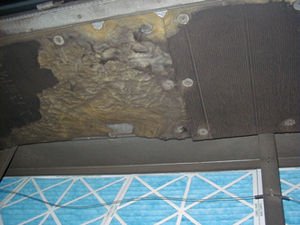 Insulation is the best way to avoid condensation in ductwork and piping systems. However, if improperly installed or damaged, some types of insulation can provide a breeding ground for mold. Closed-cell, elastomeric foam is the first and only type of insulation to provide thermal efficiency along with the necessary prevention of condensation and water vapor transmission on cold water and air handling systems. Fiberglass tends to trap and collect dirt. In fact, the air pockets that make fibrous type materials an effective insulator also makes them prone to trap and retain dirt. According to the April 2004 ASHRAE Journal, “Porous materials such as internal fibrous glass liner have been identified as a major source of fungal contamination.” The same article references a study in which fungal growth on fiberglass linings was found in 92% of 150 office buildings in Minnesota with IAQ problems. This particular study found that the average microbial levels in fibrous glass insulation are hundreds – and in some cases thousands – of times higher than the microbial levels found on closed cell foam insulation under the very same environmental conditions. Based on these facts, many experts recommend replacing fibrous glass liners with materials that are less likely to encourage fungal growth (i.e. closed-cell foam insulation) in areas where humidity is likely to exceed 70%.
Insulation is the best way to avoid condensation in ductwork and piping systems. However, if improperly installed or damaged, some types of insulation can provide a breeding ground for mold. Closed-cell, elastomeric foam is the first and only type of insulation to provide thermal efficiency along with the necessary prevention of condensation and water vapor transmission on cold water and air handling systems. Fiberglass tends to trap and collect dirt. In fact, the air pockets that make fibrous type materials an effective insulator also makes them prone to trap and retain dirt. According to the April 2004 ASHRAE Journal, “Porous materials such as internal fibrous glass liner have been identified as a major source of fungal contamination.” The same article references a study in which fungal growth on fiberglass linings was found in 92% of 150 office buildings in Minnesota with IAQ problems. This particular study found that the average microbial levels in fibrous glass insulation are hundreds – and in some cases thousands – of times higher than the microbial levels found on closed cell foam insulation under the very same environmental conditions. Based on these facts, many experts recommend replacing fibrous glass liners with materials that are less likely to encourage fungal growth (i.e. closed-cell foam insulation) in areas where humidity is likely to exceed 70%.
Why Closed Cell Foam Is the Better Choice for Mold Prevention
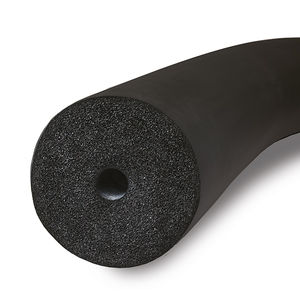 Unlike fiber-based products, which have been found to hold moisture for up to 16 days, closed-cell elastomeric foam won’t absorb moisture. Its smooth surface also inhibits the accumulation of dirt which serves as a food source for mold. Properly installed and maintained, elastomeric foam is an extremely effective deterrent to biological contamination. Even if closed-cell foam duct liner gets dirty or wet, its smooth surface makes it extremely easy to clean. The same cannot be said of fiber-based duct liners, which are notoriously difficult to clean, and deteriorate more quickly under adverse conditions. While many fiberglass duct liners are now encapsulated with a protective jacket that acts as a vapor retarder, this outer covering is easily punctured.
Unlike fiber-based products, which have been found to hold moisture for up to 16 days, closed-cell elastomeric foam won’t absorb moisture. Its smooth surface also inhibits the accumulation of dirt which serves as a food source for mold. Properly installed and maintained, elastomeric foam is an extremely effective deterrent to biological contamination. Even if closed-cell foam duct liner gets dirty or wet, its smooth surface makes it extremely easy to clean. The same cannot be said of fiber-based duct liners, which are notoriously difficult to clean, and deteriorate more quickly under adverse conditions. While many fiberglass duct liners are now encapsulated with a protective jacket that acts as a vapor retarder, this outer covering is easily punctured.
Microban Antimicrobial Product Protection
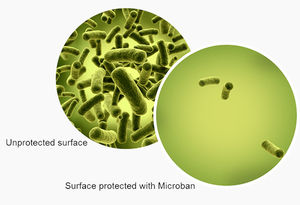 The AP ArmaFlex products are infused with Microban® antimicrobial product protection to inhibit the growth of stain and odor-causing mold and mildew from growing on any surface of the insulation. Unlike disinfectants which provide a limited residual activity once the treated surface dries, the integrated antimicrobial technology works to continuously reduce the growth of microbes throughout the entire lifecycle of a product. Built into the insulation material, it will not wash off or wear away, making it the ideal option for specification into cleanliness-critical environments such as healthcare. Microban antimicrobial chemistries are continuously working within the molecular structure of ArmaFlex products, creating an inhospitable environment for microbes to grow and multiply. Product protection begins to work as soon as a microorganism comes into contact with a product surface and the Microban antimicrobial protection penetrates the cell wall of the microorganism, disrupting the cell and making the microorganism unable to grow and reproduce. The antimicrobial protection then works continuously to maintain a consistently lower bio-burden than would be expected on a product without Microban protection. Microban antimicrobial technologies have undergone extensive independent laboratory testing and have a long history of safe use. The biocidal active components of Microban antimicrobial additives are notified with the Biocidal Products Regulation and approvedfor use by the Environmental Protection Agency of the United States of America.
The AP ArmaFlex products are infused with Microban® antimicrobial product protection to inhibit the growth of stain and odor-causing mold and mildew from growing on any surface of the insulation. Unlike disinfectants which provide a limited residual activity once the treated surface dries, the integrated antimicrobial technology works to continuously reduce the growth of microbes throughout the entire lifecycle of a product. Built into the insulation material, it will not wash off or wear away, making it the ideal option for specification into cleanliness-critical environments such as healthcare. Microban antimicrobial chemistries are continuously working within the molecular structure of ArmaFlex products, creating an inhospitable environment for microbes to grow and multiply. Product protection begins to work as soon as a microorganism comes into contact with a product surface and the Microban antimicrobial protection penetrates the cell wall of the microorganism, disrupting the cell and making the microorganism unable to grow and reproduce. The antimicrobial protection then works continuously to maintain a consistently lower bio-burden than would be expected on a product without Microban protection. Microban antimicrobial technologies have undergone extensive independent laboratory testing and have a long history of safe use. The biocidal active components of Microban antimicrobial additives are notified with the Biocidal Products Regulation and approvedfor use by the Environmental Protection Agency of the United States of America.
To learn about Microban antimicrobial technology or to broaden your antimicrobial protection knowledge, visit www.microban.com.
Microban antimicrobial product protection is limited to the product itself and is not designed to protect the users of these products from disease causing microorganisms, food borne illnesses, or as a substitute for normal cleaning and hygiene practices. Microban International, Ltd. makes neither direct nor implied health claims for the products containing Microban® antimicrobial product protection. The information presented in this blog post is solely for the purpose of providing general information regarding Microban International, Ltd.
